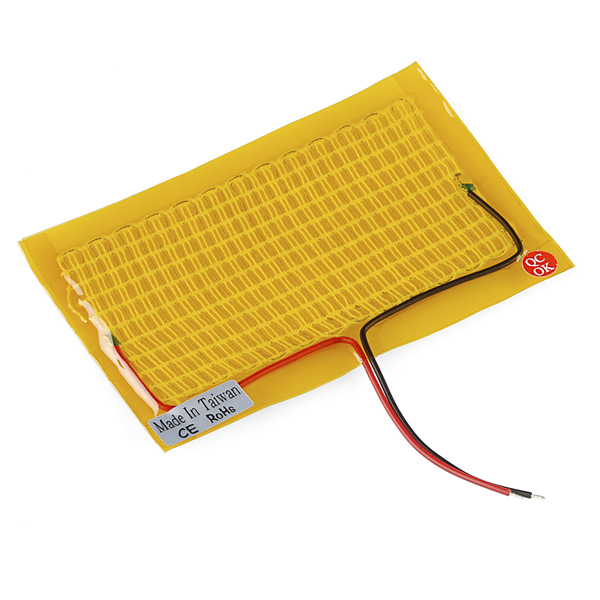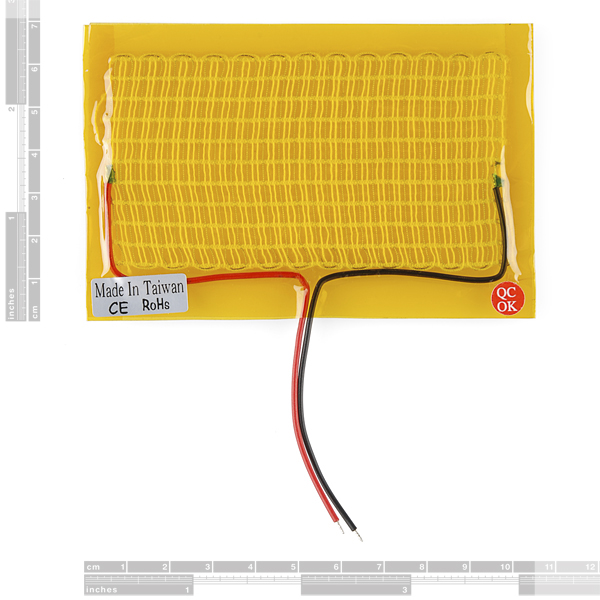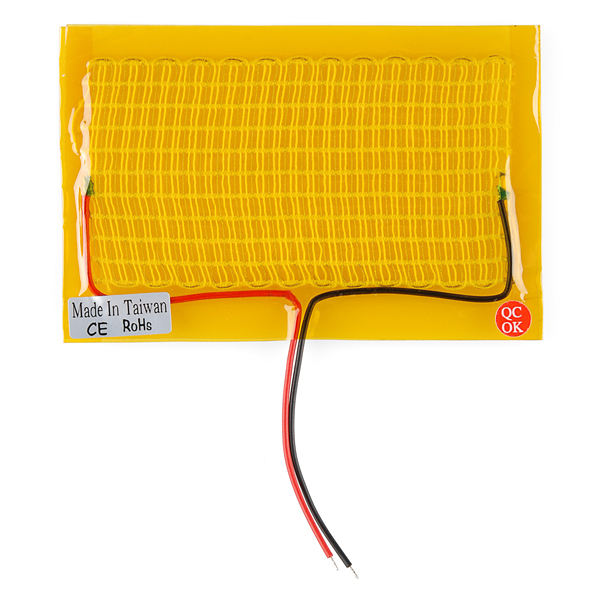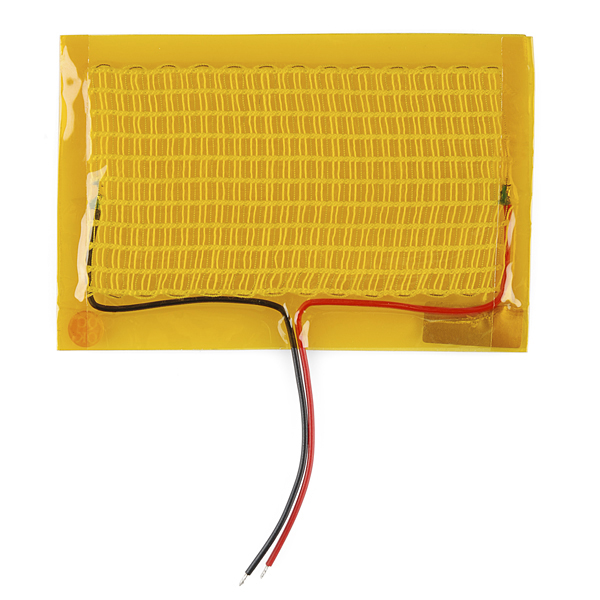These DC powered heating pads are perfect for near-body heating applications. They get warm to the touch but not too hot as long as you provide the appropriate voltage. Simply apply 5VDC to the wire leads and within minutes, the pad will begin to warm up.
These heating pads are constructed using a mesh of Polyester filament and Micro Metal Conductive Fiber folded into a protective Polyimide Film. The fact that these are low power, flexible and draw little power makes them ideal for things like hand-warmers and other heated garments. Maybe hook up a microcontroller and some sensors and make your own climate-controlled hoodie?
Attention: Please make sure to use the appropriate power requirements when operating this heating pad. Failure to do so may result in burns to bare skin. Due to this we do not recommend this product for beginners.
- Operating Voltage: 5V DC
- Operating Current: ~750mA (~6.5Ω)
- 5 x 10 cm
Heating Pad - 5x10cm Product Help and Resources
Heating Pad Hand Warmer Blanket
January 21, 2013
DIY Project Idea: Create a custom hand warmer blanket using heating pads.
DIY Heated Earmuffs
January 31, 2018
Embedded with heating pads and four Neopixel rings, these earmuffs do more than your average winter accessory to keep you warm while still looking good.
Battery Applications
These draw a lot of current, which means batteries like 9V and similar will not suffice as a power source. With any wireless applications, check the battery for excessive heat before continuing on.
Core Skill: Electrical Prototyping
If it requires power, you need to know how much, what all the pins do, and how to hook it up. You may need to reference datasheets, schematics, and know the ins and outs of electronics.
Skill Level: Competent - You will be required to reference a datasheet or schematic to know how to use a component. Your knowledge of a datasheet will only require basic features like power requirements, pinouts, or communications type. Also, you may need a power supply that?s greater than 12V or more than 1A worth of current.
See all skill levels
Comments
Looking for answers to technical questions?
We welcome your comments and suggestions below. However, if you are looking for solutions to technical questions please see our Technical Assistance page.
Customer Reviews
3 out of 5
Based on 1 ratings:
Decent heater
Pros- good size for area heating, very flexible and they are indeed waterproof in a static position (I wouldn't like to flex them a lot and test that one after a year).
Cons- They don't feel cloth-like or natural, it's a slick plastic coating, not something you want on your skin. Takes a butt-ton of current to get good heating.
I was heating an enclosed box with fan, which this does a pretty decent job at without excessive current draw, my tinkering for warming hands and comfort didn't work out so well, unless you really like shorting LiIon batteries through these, go for some nichrome





-------------------- Tech Support Tips/Troubleshooting/Common Issues --------------------
Stress Tests
Looking at the product video, the product showcase tests the temperature output of the smaller 5x10cm [ https://www.sparkfun.com/products/11288 ] at different voltages. Here are some of the results:
Note: Keep in mind that the heating pad does not recover quickly when a cooler object touches the heating pad.
Battery Power
I had a customer use this for their project to heat a horse bit up. A 9V battery didn't work as well and it was getting hot to the touch. The heating pad was putting out less heat when the battery was overheating. He then used 4 AA batteries (for about 6V) in a battery holder https://www.sparkfun.com/products/12083 and didn't have a problem using it.
does anyone know what the wire is called, the one that the heat radiates from.
"these are low power, flexible and draw little power" - this post brought to you by Sparkfun's department of redundancy department ;)
That would be the "Department of Redundancy Department"
Little power and low power are two different things ya know.
He's right, you know.
Did I mention they're flexible?
I could use this for a heated mouse. Anyone else get 'cold mouse hand' in the winter?
Shut up and take my money!
This needs to happen
How much current does this draw?
Can someone please measure the resistance of the heating pad? That way I and everyone else can calculate the current and wattage at various voltages. The 'warmup profile' is interesting but can't really be used to figure out how it'll behave in different applications. The video gives a coarse way of calculating the resistance by stating the current draw at 5v... but I'd rather just know the specs of this thing.
I'm measuring resistance at 3 Ohm. Old comment, I know, but for future reference.
How waterproof? If I wanted to put them in gloves could I hand wash them or would I have to take them out?
You wash your hands with gloves on?!?
5V, but at what current draw? and does the draw vary over time as the temp slowly increases?
From the new product post, "Each can run on 3.3-5V, and draws around 0.7A."
Hi! I am trying to heat 5 of these up to 40 C (about 100 F). I'm planning on wiring them in parallel and feeding them with a 9V 3A AC/DC converter that is regulated with a buck step-down converter. However, I'm worried that this configuration won't get the heaters hot enough. Any circuit suggestions? Thank you so much!
I like how in the suggestions there is everything you need to make a temperature controlled project.
Waterproof? Have an outdoor application to avoid dew accumulation.
If not I can always just use some sugru to seal and attach it...
Hey, I just got my heating pad, I was wondering if there is a code sample I can use, I would like to control the heating pad. Is that by any means possible?
What's the nominal resistivity on this? I'd like to drive the temperature on this put have a current limit of 1.5A.
Hey, got a couple questions that I hope some of you can answer. I'm looking to install some of these in clothing, are they washable? Can I run these through a lilypad arduino board and a 5v battery with enough heat generated to feel through fabric? If anyone can answer either one of these questions that would be great, thanks!
You cannot wash these in a washing machine, they will not survive the process. Also, you would need quite a few pads to feel the heat produced through fabric.
I am interested in trying this product in a trail cam. The camera gets cold enough at night that it won't work. one uses a 6volt lantern battery and the other uses 6 d-cell batteries(9volt). Both will work during the day if it's warmer but shut down at night and batteries only last 1-2 days. could this be hooked to the battery pack or would the draw kill the batteries anyway?
i purchased these with arduino atmega328 board, what relay i should use to this product ? Iam using LiPo battery 2000mAh 3.7V, Could you please send me a link to the product ? Thanks for help
If I have components that are rated to a low of 0 degrees Celsius, could I place this item near/around them and use a temperature sensor as a trigger to turn it on/off and keep them within their operating temperature range during the winter?
Sorry for the long sentence. Basically, can I use this to keep certain components warm during the winter?
i'm prototyping a product i'm looking to sell; can these be pulsed to maintain a lower heat temp? and can these be resized or folded rather tightly (say around the inner diameter of a 9mm pistol grip?) also whats the lowest voltage these can run off of? would a 3.7v CR123a cell be sufficient if the capacity is high enough?
another head slap momemnt :)
Thanks. That would work perfectly and be very simple.
I would like to use 4 of these from a car battery. Anyone have an off the shelf power converter recommendation ? Thanks
I'd connect two in series and hook then straight to the car battery. That should drop the effective voltage to 6V per pad. You can hook up all 4 as two strings, e.g.:
These are going in my ski boots.
hi, i want to read the temperature of a horses leg while it runs to prevent serious leg injuries. could you use this product in reverse? so if i wrapped this around a horses leg creating heat to the pad, would a slight voltage be created or change in resistance that i am able to read? cheers.
Nope, these are resistive heaters and only work in the "current in / heat out" direction. (Your results may vary in other universes.) But we do carry a number of temperature sensors you could use.
I am thinking of building an (mini) hot air balloon using these, would that even be remotely possible? I will have to use an fabric that will handle being heated and seal of the bottom of the balloon directly to the payload.
But will these provide enough heat to get the balloon in the air? And what kind of power would be able to feed these (I thought a lipo-battery)?
I haven't done the math, but I doubt these would be able to heat a large enough volume of air to a high enough temperature differential to lift the balloon envelope, heater, and battery. (For the massive source of heat this requires, there's usually no substitute for an open flame). But I may be wrong, feel free to give it a shot, and let us know how it goes!
im getting help with this part on the forums, thanks.
Hey, any idea of when this is going to be available, or if it's not going to be available? thanks
hello!
Kinda looks like we're expecting some around the end of September.
thanks great!
Might be useful for the terrarium project I am thinking about. A few of these might heat up a small one nicely.
I am trying this. I ordered 2 pads. My plan: An Arduino PWM output driving a power mosfet with 9V DC to the two heat pads connected in series, so that each pad is 4.5 V. The heat pads will be taped around a 2-inch dia PVC pipe to create a heated tube hide for snakes.
I have always wanted to do this, but not with 120 VAC heat tape/heat pads normally sold for reptile heating. But I do not mind putting 9V inside the cage.
Cool... I could use one of these with a little aluminum foil wrapped in an old towel for my cat to lay on so she would keep off the answering machine and my lap top. She will suck the heat out of anything warmer then she is.
If I wanted to heat up a circular area, would it be possible to cut them somehow or could there be some way of applying some form of a heatsink to the corners?
From the look of them, you can't cut them to shape. I'd build a sort of heat-pipe. Think: metal paperweight, with the base the size of the heating pad, and the top having the profile you want.
Yep- these are basically a very loose-weave fabric where the warp is nichrome wire and the woof is polyester, and then they're sandwiched between some kind of high-temp (probably knock-off Kapton/polymide) adhesive-backed film. We've actually had a bit of luck peeling apart the layers of tape and reshaping the heating elements- just bear in mind that doing so will change the resistance, so you'll have to adjust the power input accordingly.
I am thinking about using this to make a like seven or 14 segment display underneath thermochromic fabric. I tested it with the whole pad, and it works very responsively and well. But for money and size reasons, i want to chop apart one of these heating pads into about 7 pieces about 1 cm wide.
I'll then just solder new leads on the ends of the nichrome on each piece (isn't there something tricky about soldering to that though?) Then the resistence of each piece will be about 1/7th of the overall thing right? So then I would need to drop my (currently 12 v i am feeding it) to 12/7 V? Or else it will just get super hot /and or suck down too much juice? Finally I will try to seal up the edges of the plastic with some tape or something?
Let me know the holes in my logic please!
Soldering nichrome isn't easy; you'll need some pretty nasty flux to make it work. I'd be thinking crimp connections of some sort.
I'd take a look at our high-temp polyimide tape for sealing the edges.
You're spot on about the voltage- you want the same current flowing through the heating element, which will result in the same power dissipation per unit length. That means dividing the voltage down. Pay attention to how you cut the pad, though- the heating element is one long wire. Cut the pad along the wrong bias and you'll end up with a bunch of unconnected lengths of wire!
would it be easier to use a thermoelectric cooler using a heatsink and some wire? The end goal is being able to conditionally heat a small section in a non-filled shape
How flexible is the fabric part? I have an application where we would need to wrap a heater around a 10mm diameter tube and keep the whole assembly quite flexible. We've found both etched foil heaters and wire-wound rubber heaters aren't flexible enough for this and are currently pursuing a custom made fabric with a heater wire stitched (not woven) into it. Unfortunately this approach is quite expensive.
Ideally I'd like to talk to the manufacturer about making it in a different shape. Can you give me any leads? (it's for a good cause - http://www.eastmeetswest.org/Page.aspx?pid=344)?